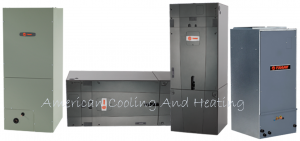Heat Pump Efficiency – Your Solution For Summer and Winter Comfort
 Benefits of an Installed Heat Pump System
Benefits of an Installed Heat Pump System
During warm weather, heat pumps and air conditioners function identically. Both HVAC approaches are designed to provide homes and businesses with the physical comfort of reliable cooling and dehumidification. The typical A/C or HP system uses a process defined as vapor compression cycling. In general, refrigerant materials are noted for the temperature increase that takes place when the materials are compressed and then rapidly expanded. Thus a cycle of circulating refrigerant material through a compression / expansion process results in mechanically generated cool air.
Whether in homes or businesses, the process remains the same. The condensing unit of the air conditioning system houses the compressor and is typically stored external to the home or office. This is the noisy maker, the energy consumer, and the home of the condensing coil.
However, when the weather changes and you need something that provides heat as well as cooling comforts, heat pump efficiency suddenly takes a valuable leap above the capacity of a standard air conditioner. It’s a reversal of processes. Whereas an A/C condensing unit is capable only of functioning as a cooling system, a heat pump can reverse the process so that the heat of compression rather than venting into the outside air ends up within your home or office living and working quarters.
Layman’s Definition of Installed Heat Pump Functionality
So, you ask. Define heat pump efficiency in simple terms. Herein are the basics:
- Heat pumps move heat from one fluid to another
- In an air-source HVAC system, air is the fluid within the home and the external fluid is the outside air source.
- In a geothermal heat system, water is the external fluid source
- In times of hot external temperatures, the heat pump moves inside air into the outside fluid
- In times of cold external temperatures, the heat within the outside fluid is moved to the inside air system.
Sophisticated Definition of Installed Heat Pump Functionality
Tip: Expect a 15-year lifecycle on the typical air-source HVAC heat pump. Furnaces usually pull 20-years. The actual processing method of a HP is as follows:
- The external compressor unit pressurizes the system refrigerant
- The pressurized refrigerant is piped inside the home
- As the inside condensing coil receives the heated gas, room air passes over the coil and heat is transferred into the passing air.
- During the process of heat exchange, the refrigerant cools and condenses
- Now pressurized as a liquid, the refrigerant passes through a throttling valve, which causes expansion, cooling, and a shift into a state of low pressure liquid
- In the cooling process, the external evaporator coil uses external air to boil the cold liquid refrigerant back into a gas
- In the event that the external air is too cold to enable adequate heat generation, supplemental electric heat strips within the air handler provide the home with reliable heat.
During winter months, ice sometimes forms on the external coil system. The heat pump then engages a periodic defrost cycle which enables the system to melt ice and resume normal operation.
 Air-Source HVAC Heat Pump Efficiency
Air-Source HVAC Heat Pump Efficiency
Every form of measurement needs a base line. Thus horsepower as well as watts and amperage define engine performance. Likewise, heat pumps also require a base line measuring gauge. We call it the Heating Season Performance Factor (HSPF). The gauging is based upon comparing the ratio of heat provided in Btu per hour to watts of energy consumed. The HSPF process also factors components such as:
- Energy loss during the systems defrost cycle
- Energy loss during system startup
- Energy loss during system stops
- And modifications due to specific climates.
Typical HSPF standards range from 7.7 for minimum efficiency equip to 8.2 for high efficiency units. Variable speed air-source HVAC systems may rate as high as 9.0. Actual efficiency performance varies from climate to climate.
When performing air-cooling services, heat pump efficiency performance is measured and rated by the Seasonal Energy Efficiency Ratio (SEER). Again: the calculations factor in concepts such as start, stop and specific climate. Current national mandates set minimum residential air conditioning SEER rates at 13.0. However some units actually exceed a 19.0 SEER rating. And again, variable speed systems typically out perform standard units.
Expect to spend around 30% more for a variable speed HP or variable speed A/C. However, expect benefits as follows:
- Better energy efficiency
- Quieter operation
- Better dehumidifying functions
- AND better home comfort.
For more details on how to fit your Arizona home with a quality installed heat pump efficiency system, contact American Cooling and Heating now.

